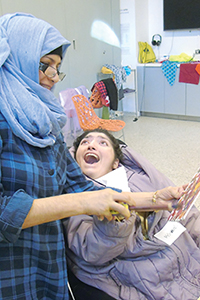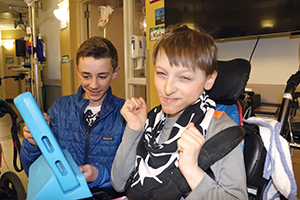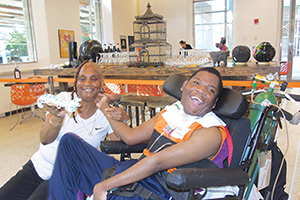By JULIE MINDA

ArchCare's Specialty Hospital for Children hosts field trips for the medically fragile children who reside at the New York City facility. Here Mehwish Aziz and her mother, Nasreen Aziz, take part in an art program at New York's El Museo Del Barrio.
During her visits with the children who live at the Specialty Hospital for Children at Terence Cardinal Cooke Health Care Center, facility chaplain Kathleen Ullmann greets each child warmly and by name. Taking care to stoop down to be face-to-face with a child in a wheelchair or bed, she'll touch the resident gently and softly sing her signature song — "You Are My Sunshine" — into the child's ear.
Most of the children who live at the pediatric long-term care facility are so profoundly disabled that they can't use words to communicate; many have impaired motor skills and can't coordinate their muscle movements to grasp her hand. Ullmann is alert to the satisfied sigh or a head nod that indicates she's made a connection with those children.
The vast majority of these children can experience the world and its pleasures through some combination of sight, sound, touch, smell or taste, according to Dr. Vicki-Jo Deutsch, a pediatrics specialist and medical director of the Specialty Hospital at Terence Cardinal Cooke Health Care Center.
So, staff and volunteers get creative in the ways they bring joy and stimulation to the children's daily lives. Since each child's cognition and sensory intake differs, to do this effectively requires a personal connection between caregiver and child, astute attention in interactions and a focus on abilities rather than disabilities.
"Our philosophy is that every individual deserves respect, and we want to provide dignity and love to all of our residents," said Deutsch. "It's about enhancing whatever quality of life they have, and we work hard as a team to do that."
Permanent home
The 56-bed Specialty Hospital for Children is in the Terence Cardinal Cooke center, a nine-story Harlem facility that also houses a skilled nursing facility and rehabilitation, as well as units for adults with Huntington's or HIV/AIDS. Terence Cardinal Cooke is part of ArchCare, the health care ministry of the Archdiocese of New York.
Across the country in Portland, Ore., Providence St. Joseph Health operates the Center for Medically Fragile Children. The 40-bed long-term care pediatric nursing facility is on the campus of Providence Portland Medical Center.
Patients at the ArchCare and Providence St. Joseph facilities require hands-on assistance with virtually every activity of daily living.
While both sites offer respite care and other short-term stay options, most of the children are long-term residents.
Both sites admit patients from infancy through age 21. Some patients require ventilators to breath, some take all nourishment through a feeding tube. Almost all are unable to walk and so use wheelchairs. Many of these patients will not survive to adulthood and will live out their lives at the facility.
However, medical advancements are prolonging the lives of some children with severe disabilities and the Specialty Hospital and Center for Medically Fragile Children now have a small number of patients who have grown into adulthood there. (Those older than age 21 at the Portland facility in time will transition to an adult medical group home or foster home, with the aid of the Portland facility staff. The New York facility enables residents to live there permanently, even after age 21.)
Some of the discovery of how to connect with the children happens through trial and error, said Katherine Kreutzer, a Portland resident who — along with her two teen daughters — volunteers at the Portland center. "We volunteers are encouraged to give the children options, wait for a response, to speak compassionately, assume they are listening even if they don't respond. (The communication) comes organically over time."

Jace Hayden, a resident of the Center for Medically Fragile Children in Portland, Ore., enjoys a visit from volunteer Max Elmgren. Max is a sixth grade student at St. Thomas More Catholic School in Portland. He volunteers through the center's Friend-to-Friend program.
A few of the children can speak, said chaplain Kelly Schmidt of the Portland center, and a greater number can use other vocal sounds, such as whoops, giggles, gasps, sighs and chattering to communicate.
Some communicate through facial expression, modified sign language or pictures on cards. Some children are able to use computers activated by touch or eye gaze to select words from a limited list for the computers to "speak."
Parents, siblings and grandparents can share information on how best to connect with the children, said Schmidt. "A brother or sister can share that when they were a baby they loved this blanket or that song."
All five senses
Both the New York and Portland facilities for medically fragile children have staffs that include physician specialists, nurses, certified nursing assistants, social workers, chaplains, housekeepers and support personnel. The centers also have numerous volunteers. In Portland, elementary school-aged children from local Catholic schools visit to read to and play with the children. About 15 of the 39 patients at the Oregon facility go off-site for school. A teacher comes on-site to instruct other children. The New York facility brings educators in for schooling.

Jahri Lincoln, a resident of ArchCare's Specialty Hospital, and his mother Antoinette Hubbard play during the field trip to the Museo Del Barrio.
Staff and volunteers receive instruction on how to safely interact with the children, as well as tips on communicating with them successfully. But, much of the real progress in making important personal connections happens organically. Meaningful connection requires caring, Deutsch said. Everyone on staff from clinicians to housekeepers tries to connect with the children, she said.
With the help of staff and volunteers, the children look at pictures, choose decorations for their rooms and watch movies for visual stimulation. They get aromatherapy, and draw with fruity-smelling markers. At the Oregon facility, the aroma of cookies baked fresh on the floors stimulates the children's sense of smell. Children who are able to eat solid foods sample the treats to stimulate their taste buds. And for tactile stimulation, the caregivers give the children massages and help them play with lotions, foams and other items that are fun to touch.
Both the Specialty Hospital and Center for Medically Fragile Children use what's called Snoezelen multisensory experiences to combine several types of stimulation. For instance, staff will set up lighting, smells, sounds and textures in a room according to the needs of a child or small group of children, to provide multiple sensory experiences simultaneously.
Lots of outlets
At the Portland center children can run their fingers through the soil and smell the flowers in a sensory garden. They can experience buoyancy and fluid movement during aquatic therapy.
At both facilities children can listen to their favorite music and express themselves through art projects. They can get moving using sport recreation equipment adapted for them.
The Specialty Hospital and Center for Medically Fragile Children also provide religious and spiritual experiences for the children, in line with their families' wishes. In Oregon, in the chapel, Schmidt and crew play spiritual music. Children touch decorative banners made of ribbons and run their fingers through holy water. Children touch dried corn husks or spiky pineapples, as Schmidt talks about how God's kingdom can grow like crops.
The Portland center's Brown said it is very common at that facility for staff and volunteers to engage small groups of children in therapies or activities, based on preferences they've expressed or based on their abilities. The group work is for both learning and socialization.
Whether the children are in group or one-on-one therapy or in more casual interactions, Brown said, staff and volunteers use a highly individualized approach to understand and respond to the needs and preferences of the children. She said staff and volunteers get to know the children to connect with them in a way that is most enjoyable and beneficial.
Copyright © 2018 by the Catholic Health Association
of the United States
For reprint permission, contact Betty Crosby or call (314) 253-3490.